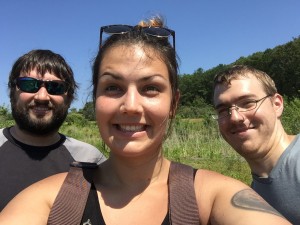Sean McCanty, What I Did This Summer?
My research is investigating the effects of active stream channel restoration in an agricultural setting. Specifically I am looking at how the ecology of the system changes with respect to biological community assemblage and diversity, greater stream network connectivity, and ecological functionality in terms of matter and energy flow. My study system is a decommissioned cranberry bog in Plymouth, MA, which has been out of service for 4 years. It is scheduled to undergo active restoration of the stream channel and surrounding land at the end of this year. We will be comparing changes measured by biological, chemical, and physical habitat collections to two control locations: a minimally impacted headwater stream under land conservation and an actively producing cranberry bog. By comparison of the restoration site through time (pre-restoration, during restoration, and post restoration) and comparing to these control sites we hope to get a sense of the changes undergoing during restoration both in terms of directionality and speed.

This summer, my research has continued as planned. Much of my work revolves around summer field sampling and most of my time was dedicated to this. In the summer we collect benthic macroinvertebrate samples (insects, crustaceans, and other water dwelling invertebrates), habitat measurements, water chemistry, stream metabolism data, and fish community analysis. We also collect a subsample of invertebrates, fish, and plant material in hopes of constructing a food web based on stable isotopes of carbon and nitrogen, which will tell us more about how each site is utilizing its energy input. These data form the bulk of my research in categorizing the current state of all 3 sites.
Additionally this summer, we had an undergraduate assistant through the SFE’s CREST REU (Research Education for Undergraduates). Damon is a Miami University of Ohio senior and he aided us in fieldwork as well as creating his own project from the vast amount of data we collected over the spring that he independently analyzed. The combination of first-hand work experience and pursuing an independent project is the corner stone of the CREST program’s benefit to undergrads interested in a career in graduate school or academic science. Damon’s work culminated in a poster presented at the end of the program and we have high hopes of working it into a larger paper looking at habitat and macroinverebrate community structure in the near future.
We also successfully received over $7000 from a crowdfunding page we launched at the beginning of the summer, tapping into the amount of people interested in restoration and freshwater biodiversity. Most of the funds will be directed towards genetic work for Tom’s research, but there is a substantial amount that will benefit my work, particularly for analysis of stable isotopes and providing more lab supplies and refurbished equipment.